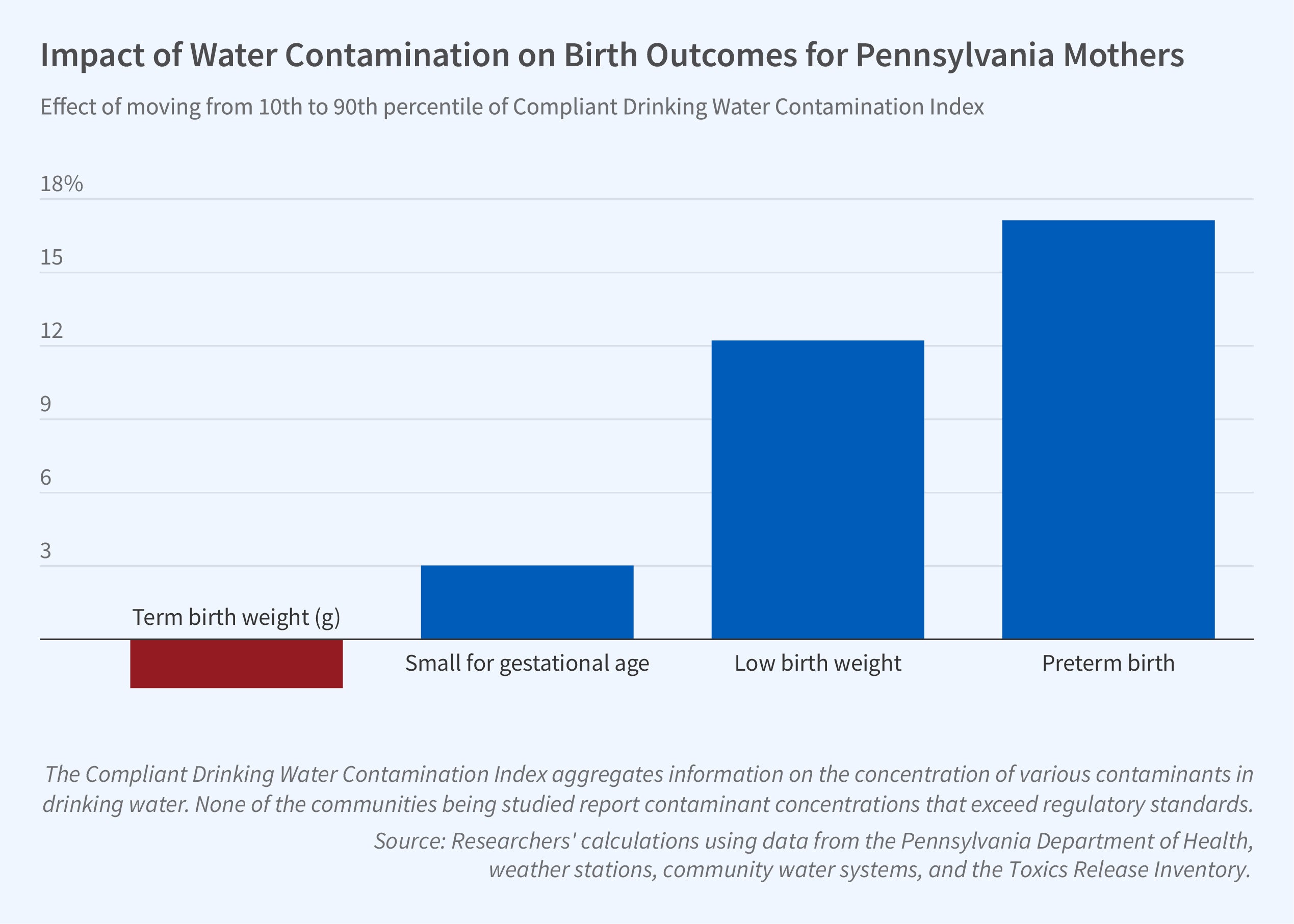Drinking Water Contamination, Even at Low Levels, Affects Birth Outcomes
 The Safe Drinking Water Act regulates over 90 contaminants — such as lead and arsenic — in community water systems. These regulations establish maximum contaminant levels (MCLs) for each contaminant; levels that exceed MCLs are considered violations. However, even among water systems that meet regulatory standards, the levels of contaminants can vary. In Drinking Water Contaminant Concentrations and Birth Outcomes (NBER Working Paper 31567), researchers Richard DiSalvo and Elaine L. Hill show that elevated levels of contaminants — even in communities where the concentrations are compliant with regulations — adversely affect birth outcomes.
The Safe Drinking Water Act regulates over 90 contaminants — such as lead and arsenic — in community water systems. These regulations establish maximum contaminant levels (MCLs) for each contaminant; levels that exceed MCLs are considered violations. However, even among water systems that meet regulatory standards, the levels of contaminants can vary. In Drinking Water Contaminant Concentrations and Birth Outcomes (NBER Working Paper 31567), researchers Richard DiSalvo and Elaine L. Hill show that elevated levels of contaminants — even in communities where the concentrations are compliant with regulations — adversely affect birth outcomes.
The analysis links birth records for Pennsylvania between 2003 and 2014 to data on drinking water contaminant levels in community water systems from the US Environmental Protection Agency and the Pennsylvania Department of Environmental Protection. Each infant is matched to the authors’ water quality index for the mother’s place of residence during their gestational period.
The water quality index measures the average contaminant concentrations as a share of the MCL across all contaminants that were sampled in a community water system. For the typical infant in the study, average contaminant levels were 8 percent of the MCL. At the 90th percentile, contaminant levels were 17 percent of the MCL, whereas at the 10th percentile, they were only 2 percent.
The study focuses on the 97 percent of infants whose gestation did not overlap with a water quality violation. In the absence of such a violation, mothers are unlikely to be aware of the contamination or to take actions to avoid contaminants — such as purchasing bottled water or filtering tap water.
The study compares outcomes for siblings who experienced different levels of water contamination while in utero. Infants who were exposed to worse water quality during their gestation had lower birth weight and shorter gestation than their siblings who experienced better water quality. Shifting from the 10th to the 90th percentile of water contamination is associated with an increase of 0.8 percentage points (12 percent) in the probability of a low birth weight delivery.
Water contamination affects birth weight through two different channels. First, it reduces gestational age. The same shift from the 10th to the 90th percentile of water contamination raises the likelihood of preterm birth by 1.4 percentage points (17 percent). Second, birth weight conditional on gestational age is lower, suggesting that water contamination may cause intrauterine growth restriction. Higher levels of contaminants are also associated with a lower term birth weight, a measure only available for infants born at full term, and a higher likelihood of babies being small for their gestational age.
The researchers conclude that even water contamination levels that meet regulatory standards can have detrimental effects on infant health. They also note that while water regulations treat each contaminant separately, the toxicology literature suggests that mixtures of contamination may be more problematic for human health. Such interactions could be captured if water quality was described using measures that could account for contaminant mixtures, such as the index used in this research.
— Robin McKnight
The researchers acknowledge support from the Office of the Director of the National Institutes of Health under award number DP5OD021338 (PI: Hill) and the University of Rochester Environmental Health Sciences Center, an NIH/NIEHS-funded program (P30 ES001247).


